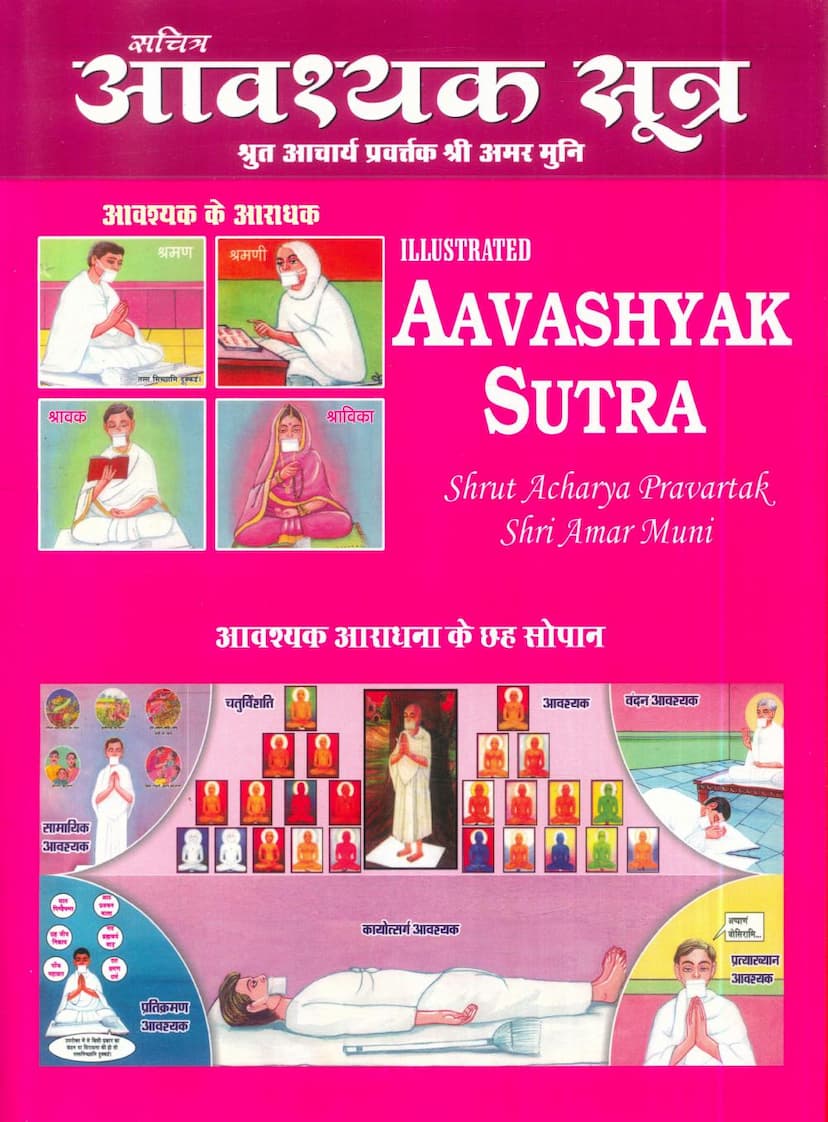Agam 28 Mool 01 Aavashyak Sutra Sthanakvasi
Added to library: September 1, 2025

Summary
This Jain text, "Agam 28 Mool 01 Aavashyak Sutra" by Amarmuni, published by Padma Prakashan, is a detailed explanation of the Aavashyak Sutra, a fundamental text in Jainism. The book aims to provide an illustrated, multilingual (Hindi-English) guide to this essential ritual practice for both monks (Shraman) and lay followers (Shravak).
Here's a comprehensive summary of the provided pages:
Core Concept of Aavashyak:
- The Aavashyak Sutra is presented as a crucial practice for spiritual purification. Just as a bird shakes off dirt from its wings, a practitioner uses pratikraman (a process within Aavashyak) to remove karmic impurities from vows, thus lightening the soul and enabling spiritual advancement.
- It emphasizes the need for daily self-reflection and self-criticism, performed in the morning and evening, to purify the soul and reveal its inherent nature of knowledge, perception, and happiness. This practice is seen as the final step towards salvation.
The Six Steps of Aavashyak:
The Aavashyak is described as having six essential steps, which are the foundation of spiritual purification and lead to ultimate liberation:
- Samayik: The first step, emphasizing equanimity. It involves maintaining a balanced state of mind amidst dualities like pleasure/pain, profit/loss, life/death. It is the bedrock of spiritual practice.
- Chaturvinshati Stav: The second step, involving devotional praise of the 24 Tirthankaras. This fosters devotion and helps in embodying their virtues.
- Vandan: The third step, involving respectful salutation, particularly to the spiritual teacher (Guru). It highlights the importance of humility and gratitude.
- Pratikraman: The fourth step, meaning "to return." It involves returning from wrong perceptions to right vision, from non-restraint to vows, from ignorance to knowledge, and from impure states to pure ones. It is the core of Aavashyak, involving self-criticism and repentance for faults.
- Kayotsarg: The fifth step, involving detachment from the physical body and its activities. It's a practice of deep meditation and self-purification by transcending physical consciousness.
- Pratyakhyan: The sixth and final step, involving specific renunciations and voluntary austerities. This is considered the most crucial step for removing karmic dust and progressing towards liberation.
Structure and Purpose of the Book:
- Comprehensive and Illustrated: The book is a "Sachitra Aavashyak Sutra" (Illustrated Aavashyak Sutra), featuring colored pictures to visually explain the concepts and practices.
- Multilingual: It provides both Hindi and English translations and expositions, making it accessible to a wider audience.
- Commentary and Exposition: The text includes detailed explanations (vivechan) of the sutras, elaborating on their meaning and significance.
- Dedication: The book is dedicated to Gurudev 'Bhandari' Shri Padmachandra Ji Maharaj, a prominent figure in the Jain tradition.
- Editorial Vision: The project aims to make Agamic knowledge accessible to the general public, not just scholars, by presenting it in simple language with illustrations.
- Contribution of Gurudev Amar Muni: The book is a testament to the vision of Gurudev Shri Amar Muni Ji Maharaj, who conceptualized and guided the publication of illustrated Agams to increase the interest in Jain scriptures.
Key Sections and Themes:
- Page 1-2: Introduction to Aavashyak as a spiritual purification process, the six steps, and the bird analogy for shaking off karmic dust.
- Page 3-17: Title pages, publisher information, dedication, and acknowledgments, emphasizing the collaborative effort and the spiritual significance of the publication.
- Page 18-24: Publisher's note and editorial by Mahendra Jain and Amar Muni, highlighting the challenges and rewards of publishing illustrated Agams and the historical context of the Aavashyak Sutra.
- Page 25-87 (and beyond): Detailed breakdown of the Aavashyak Sutra into its six parts (Samayik, Chaturvinshati-Stav, Vandan, Pratikraman, Kayotsarg, Pratyakhyan). Each part includes:
- Introduction: Explaining the purpose and significance of that step.
- Sutras: The original Jain scriptural text.
- Translation and Exposition: Hindi and English explanations of the sutras.
- Illustrations: Relevant colorful pictures to clarify the meaning.
- Specific Faults (Atichar): For Pratikraman and other steps, the text lists specific minor faults (atichar) that practitioners should be aware of and avoid, categorized by the vow or practice (e.g., faults in knowledge, perception, vows of non-violence, truthfulness, stealing, celibacy, non-possession, etc.).
- Shravak Aavashyak Sutra: A separate section details the Aavashyak practices as applicable to lay followers (Shravak), with specific vows and their associated faults.
- Samayik Vidhi: Detailed step-by-step procedure for performing Samayik.
- Bhavarth: Explanations of the importance and benefits of each step, including the concept of Samayik being the ultimate path to liberation.
- Glossary/Annexure: Explanations of specific terms and procedures, including the 32 faults related to Samayik.
- Publisher's Note and Author's Biography: Information about the publisher (Padma Prakashan) and the chief editor, Shrut Acharya Pravartak Shri Amar Muni Ji Maharaj, highlighting his spiritual journey and contributions.
In essence, the book is a comprehensive manual for understanding and practicing the Aavashyak, a cornerstone of Jain spiritual discipline. It blends scriptural text with devotional context, practical guidance, and visual aids to make this profound practice accessible and meaningful.